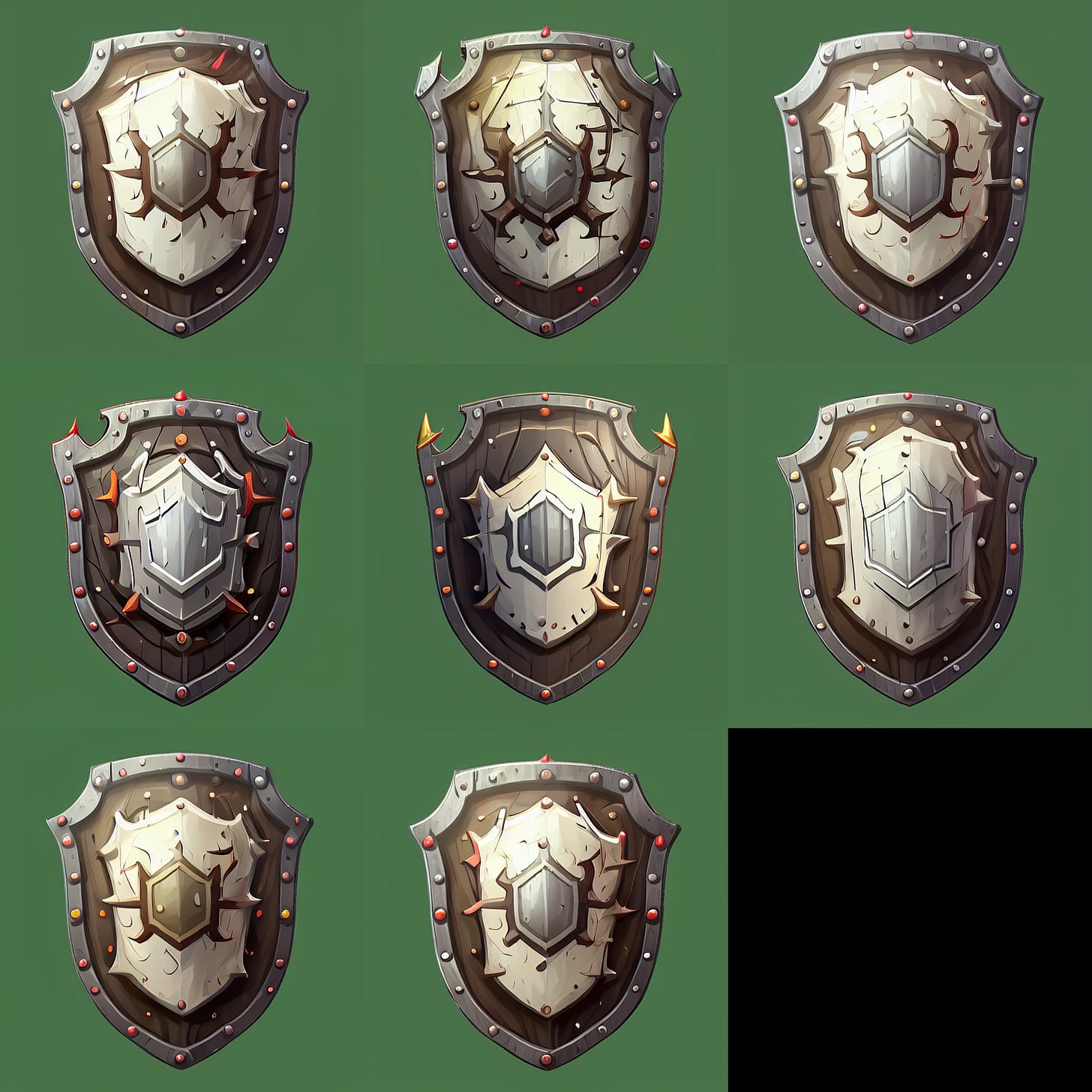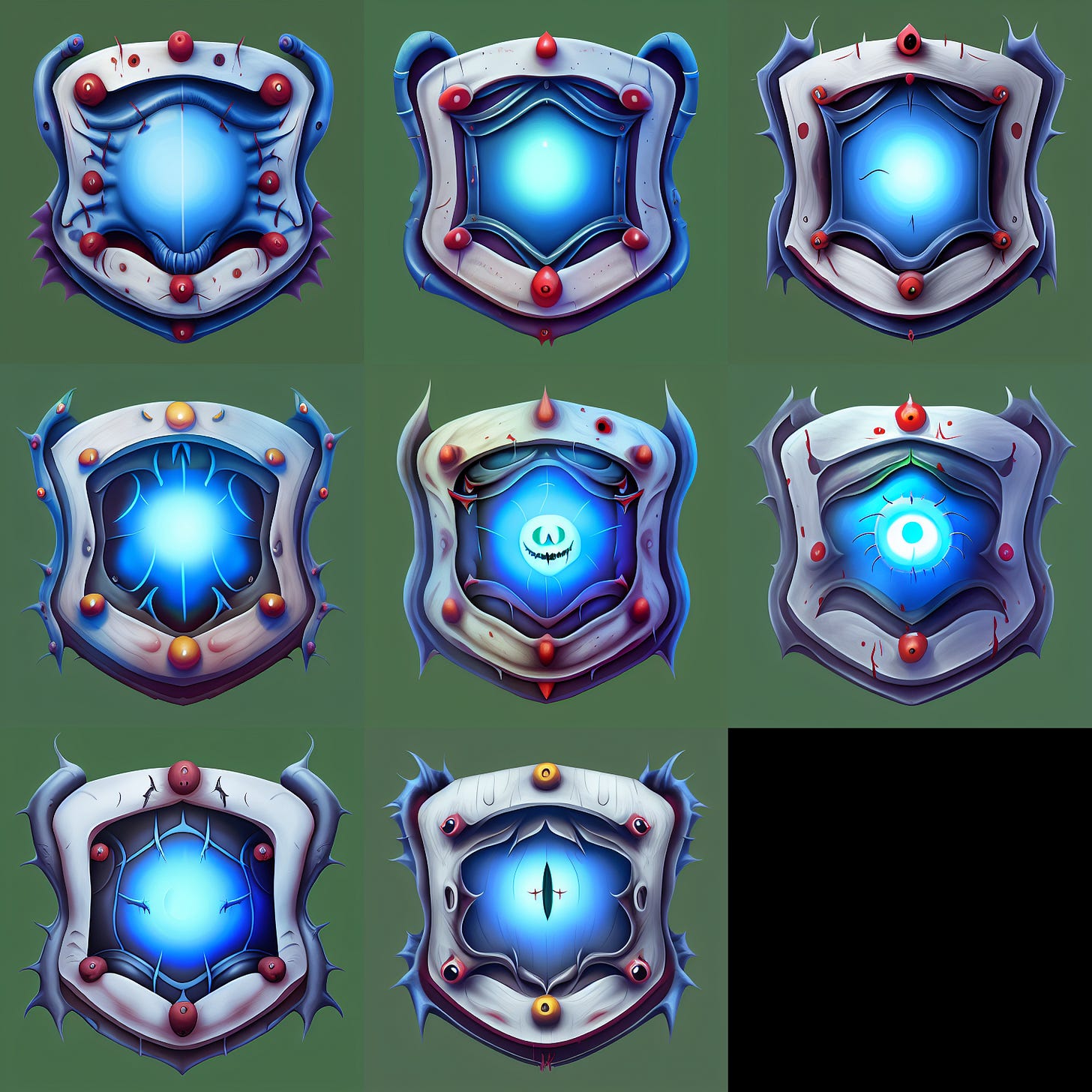Guide to Generate Infinite Game Assets by Fine-tuning Stable Diffusion
Your imagination is the limit
Hello everyone,
In this post, I want to share my first attempt to generate 2D game assets using stable diffusion. There is a lot to optimize in this flow, and I will likely do follow-up posts about it, but I believe this is a good start.
I’m not the first to attempt something like this, and there are even folks and companies who are way ahead, about to turn this into a commercial product. For example, some mind-blowing work by https://twitter.com/emmanuel_2m
Overview of what I did
I started with getting some 2d assets that I wanted to iterate on. In this case, I got ~100 images of shields from https://www.gamedevmarket.net/. You can likely achieve similar or better results with a smaller or larger number of images, and you can get them wherever you like, whether it’s painting by hand or using SD or MidJourney to generate them.
For fine-tuning, I used EveryDream trainer. It’s a very interesting alternative to Dreambooth implementations, and I’ll do more deep dives into ED. Meantime, check out their Discord.
After fine-tuning, I used Automatic1111 WebUI (link to our way of installing it) and generated a bunch of variations using txt2img and img2img.
Step-by-step guide
1 - Caption your assets
First, install EveryDream Tools:
Start WSL or however you navigate in your folders. In my case, I go to my base directory:
cd ~Type:
git clone https://github.com/victorchall/EveryDream.gitGo to the directoy:
cd EveryDream/I had issues installing the environment with environment.yaml so doing it manually
Let’s create the environment first:
conda create --name edtools python=3.10Activate environment:
conda activate edtoolsInstall requirements:
pip install -r requirements.txtManually install one more package:
pip install torch==1.12.1+cu113 torchvision==0.13.1+cu113 --extra-index-url https://download.pytorch.org/whl/cu113
And clone Blip:
git clone https://github.com/salesforce/BLIP scripts/BLIP
Now we caption the images
Place your assets in the input folder of the EveryDream repo. There is a folder inside the directory we cloned called input, and I pasted my 100 images of shields inside there.
Then run the following command:
python scripts/auto_caption.pyNow check the results in the output folder of the EveryDream directory. Make sure all items contain the name of a thing that you are training for. In my case, it’s “shield,” and I had to change a few names manually from an “umbrella” or “round object”.
Now instead of a shield, I will be using some random identifiers. Inspired by this Reddit post. Link I ended up choosing a combination of two rare random tokens:
“loeb bnha”Let’s replace “shield” in those names with “loeb bnha” using this command:
python scripts/filename_replace.py --img_dir output --find "shield" --replace "loeb bnha"
The training data is ready. This is how it looks in my case
2 - Fine-tuning using EveryDream
Installation of EveryDream Trainer
Once again, I start by going to my base directory:
cd ~. make sure the conda environment is deactivated:conda deactivateClone the everyream trainer repo:
git clone https://github.com/victorchall/EveryDream-trainer.gitGo inside the folder:
cd everydream-trainer/Create environment:
conda env create -f environment.yamlAnd activate the environment:
conda activate everydream
Fine-tuning process
Open the directory folder:
explorer.exe .And if there is no folder called “training_samples”, create a new one
Inside training samples, I create a folder called “shields” and paste my captioned images there
Go back to the base everydream folder and paste the ckpt that you’ll be using as a source. In my case, it’s the v1.5 emaonly.
https://huggingface.co/runwayml/stable-diffusion-v1-5For this initial test, I won’t optimize anything; I’ll be covering that later.
Simply launch the training with the command:
python main.py --base configs/stable-diffusion/v1-finetune_micro.yaml -t --actual_resume v1-5-pruned-emaonly.ckpt -n shield_1 --data_root training_samples/shieldsThis will run the training. In my case, I have 100 images. The default micro setting is to show each image 60 times per epoch, 4 images at a time. So 100/4*60=1500 steps per epoch + testing/validation steps. I’m training for 6 epochs total.
At the end of each epoch, ckpt will be generated to find the optimal one.
With 2 seconds per iteration, I expect a training time of 2*1700*6/60 = 340 minutes. Probably a bit too many repeats/epochs, but let’s see if the results are worth it.
After seeing the results, I can tell that 1 or at most 2 epochs would have been plenty
Preparing ckpt files to generate images
Once fine-tuning is done, go to the logs folder in everydream-trainer and open the checkpoints folder. In my case, it is
everydream-trainer\logs\shields2022-12-04T23-53-20_shield_1\checkpointsYou should see multiple checkpoints, one for each epoch + the one called last.ckpt. Usually, the latter is the same as the last epoch’s file.
I can tell that 6 epochs, in this case, was total overkill, and I could have done much smaller tuning. I’ll write more about it later, but you can play with adjusting the number of repeats and epochs in the YAML file before fine-tuning. In this case, the file would have been
everydream-trainer\configs\stable-diffusion\v1-finetune_micro.yamlThe ckpt files in the logs directory are usually not pruned, 11GB files. To prune them, you can go to a folder called scripts, copy the file called prune_ckpt.py and paste it into the folder of logs with ckpt
Then from your console:
go to that folder:
cd logs/shields2022-12-04T23-53-20_shield_1/checkpoints/And run
python prune_ckpt.py --ckpt last.ckptYou’ll see a new pruned ckpt file generated that’s 2GB
Copy the ckpt file and paste into the model folder for Automatic WebUI. In my case
stable-diffusion-webui\models\Stable-diffusion
3 - Let’s generate some assets
Launch SD WebUI as usual and load the pruned checkpoint you just copied
For the first generation, I only changed the Batch Size to 8 and used “loeb bnha” as a prompt.
This is already promising. Another way to generate interesting results is by pasting one of the captions I used for training data. So let’s try: a blue loeb bnha with a lightning bolt sticking out of it's center and rivets around it
Let’s try to get a bit creative: a blue loeb bnha with the face of hulk on it
My model is overtrained, so I pruned the ckpt after the first epoch, loaded it, and tried several of the same prompts. I think something in-between is optimal in this case
All future images are generated with the first checkpoint, ie, the one generated after the first epoch.
Img2img is another great way to generate variations. You can send one of the generated images or use the original images as a starting point. I’m doing the latter in this case. Here are some more examples of what I managed to generate


























